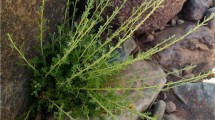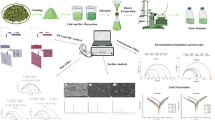Abstract
This research investigates the behaviour of microbiologically influenced corrosion (MIC) of sulfate-reducing bacteria (SRB) on API 5L X65 carbon steel in the presence of CO2 gas. The weight loss test, electrochemical impedance spectroscopy (EIS) and potentiodynamic polarisation were implemented to determine the corrosion behaviours. Biofilms, corrosion products and pit penetration rate were characterised by field emission scanning electron microscopy (FESEM), X-ray diffraction (XRD) and infinite focus microscope (IFM). Findings from weight loss confirmed that specimens in the absence of SRB promote uniform corrosion with a higher corrosion rate value of 1.05 mm per yr compared to the pit penetration rate of 0.12 mm per yr. The IFM analysis shows that samples with the SRB presence promote localised corrosion due to the higher pit penetration rate value of 0.81 mm per yr than the uniform corrosion rate of 0.57 mm per yr. Furthermore, EIS measurements confirmed that corrosion products and biofilm formations affect the corrosion process. The surface analysis proved the presence of sulfur on metal specimens exposed to SRB in CO2 environments; this indication supports the formation of the FeS layer. Finally, the XRD test affirmed the formation of Fe3C and FeS in samples exposed to the SRB.















Similar content being viewed by others
Data Availability
All data generated or analysed during this study are included in this published article.
References
Igi S, Sakimoto T, Endo S (2011) Effect of internal pressure on tensile strain capacity of X80 pipeline. Procedia Eng 10:1451–1456. https://doi.org/10.1016/j.proeng.2011.04.241
Al-Jaroudi SS, Ul-Hamid A, Al-Gahtani MM (2011) Failure of crude oil pipeline due to microbiologically induced corrosion. Corros Eng Sci Technol 46:568–579. https://doi.org/10.1179/147842210X12695149033819
Okonkwo P, Mohamed AMA (2014) Erosion-corrosion in oil and gas industry: a review. Int J Metall Mater Sci Eng 4:7–28
Malaysian Gas Association (2017) Malaysia: Natural Gas Industry Annual Review 2017
Yulia F, Marsya S, Bobby Y et al (2020) Design and preparation of succinic acid-based metal-organic frameworks for CO2 adsorption technology. Evergreen 7:549–554. https://doi.org/10.5109/4150475
Kim S, Il LY, Lee D et al (2021) Effects of flue gas recirculation on energy, exergy, environment, and economics in oxy-coal circulating fluidized-bed power plants with CO2 capture. Int J Energy Res 45:5852–5865. https://doi.org/10.1002/er.6205
Satyanarayana KG, Mariano AB, Vargas JVC (2011) A review on microalgae, a versatile source for sustainable energy and materials. Int J Energy Res 35:291–311. https://doi.org/10.1002/er.1695
Eduok U, Khaled M, Khalil A et al (2016) Probing the corrosion inhibiting role of a thermophilic Bacillus licheniformis biofilm on steel in a saline axenic culture. RSC Adv 6:18246–18256. https://doi.org/10.1039/c5ra25381k
Shah M, Abdul Manap NR, MawardiAyob MT et al (2021) Effect of pH2S influence on austenitic stainless steel 316L corrosion behaviours in chloride environment/Kesan pengaruh tekanan separa gas H2S terhadap tingkah laku kakisan keluli tahan karat 316L di persekitaran klorida. Malaysian J Civ Eng. https://doi.org/10.11113/mjce.v33.16697
Maruthamuthu S, Kumar BD, Ramachandran S et al (2011) Microbial corrosion in petroleum product transporting pipelines. Ind Eng Chem Res 50:8006–8015. https://doi.org/10.1021/ie1023707
De Paula MS, Gonçalves MMM, Rola MAC et al (2016) Carbon steel corrosion induced by sulphate-reducing bacteria in artificial seawater: electrochemical and morphological characterizations. Rev Mater 21:987–995. https://doi.org/10.1590/S1517-707620160004.0091
Idris MN, Mahat NA, Othman NK, Shahrani FK (2017) Anaerobic bacteria treatment by benzyl dimethyl (2-hidroxyethyl) ammonium chloride for carbon steel pipeline system. J Built Environ Technol Eng 2:12–17
AlAbbas FM, Bhola SM, Spear JR et al (2013) The shielding effect of wild type iron reducing bacterial flora on the corrosion of linepipe steel. Eng Fail Anal 33:222–235. https://doi.org/10.1016/j.engfailanal.2013.05.020
Pessu F, Barker R, Neville A (2017) Pitting and uniform corrosion of X65 carbon steel in sour corrosion environments: the influence of CO2, H2S, and temperature. Corrosion. https://doi.org/10.5006/2454
Liu H, Cheng YF (2018) Mechanistic aspects of microbially influenced corrosion of X52 pipeline steel in a thin layer of soil solution containing sulphate-reducing bacteria under various gassing conditions. Corros Sci 133:178–189. https://doi.org/10.1016/j.corsci.2018.01.029
Liu H, Gu T, Zhang G et al (2018) Corrosion of X80 pipeline steel under sulfate-reducing bacterium biofilms in simulated CO2-saturated oilfield produced water with carbon source starvation. Corros Sci 136:47–59. https://doi.org/10.1016/j.corsci.2018.02.038
Liu H, Meng G, Li W et al (2019) Microbiologically influenced corrosion of carbon steel beneath a deposit in CO2-saturated formation water containing Desulfotomaculum nigrificans. Front Microbiol 10:1–13. https://doi.org/10.3389/fmicb.2019.01298
Hajar HM, Zulkifli F, Mohd Sabri MG, Wan Nik WB (2016) Protection against corrosion of aluminum alloy in marine environment by Lawsonia inermis. Int J Corros 2016:4891803. https://doi.org/10.1155/2016/4891803
Mohd Sukarnoor NI, Ferry M, wan nik wan sani, Saidin J (2015) Evaluation of tannin from Rhizophora apiculata as natural antifouling agents in epoxy paint for marine application. Prog Org Coat. https://doi.org/10.1016/j.porgcoat.2014.12.012
Zinkevich V, Bogdarina I, Kang H et al (1996) Characterisation of exopolymers produced by different isolates of marine sulphate-reducing bacteria. Int Biodeterior Biodegrad 37:163–172. https://doi.org/10.1016/s0964-8305(96)00025-x
Al Shehadat S, Gorduysus MO, Hamid SSA et al (2018) Optimization of scanning electron microscope technique for amniotic membrane investigation: a preliminary study. Eur J Dent 12:574–578. https://doi.org/10.4103/ejd.ejd_401_17
Fan MM, Liu HF, Dong ZH (2013) Microbiologically influenced corrosion of X60 carbon steel in CO2-saturated oilfield flooding water. Mater Corros 64:242–246. https://doi.org/10.1002/maco.201106154
Abdullah A, Yahaya N, Norhazilan MN, Rasol RM (2014) Microbial corrosion of API 5L X-70 carbon steel by ATCC 7757 and consortium of sulfate-reducing bacteria. J Chem. https://doi.org/10.1155/2014/130345
Mahat NA, Othman NK, Sahrani FK, Idris MN (2015) Inhibition of consortium sulfate reducing bacteria from crude oil for carbon steel protection. Sains Malaysiana 44:1587–1591
Pessu F, Barker R (2017) Pitting and uniform corrosion of X65 carbon steel in sour corrosion environments: the influence of CO2, H2S and temperature. Corrosion 73:451–604. https://doi.org/10.5006/2454
Pessu F, Hua Y, Barker R, Neville A (2018) A study of the pitting and uniform corrosion characteristics of X65 carbon steel in different H2S-CO2-containing environments. Corrosion 74:886–902. https://doi.org/10.5006/2537
Solmaz R (2017) Gold-supported activated NiZn coatings: hydrogen evolution and corrosion studies. Int J Energy Res 41:1452–1459. https://doi.org/10.1002/er.3724
Almeida PF, Carvalho EB, Souza ER et al (2006) Overview of sulfate-reducing bacteria and strategies to control biosulfide generation in oil waters. Mod Biotechnol Med Chem Ind 661:1–15
Al-Khafaji AAS(2017) Diversity of bacteria in crude oils and determination of corrosion potential for microbiologically influenced corrosion on carbon steel. npj Mater Degrad 6: Article number: 35
Idris MN, Daud AR, Mahat N et al (2016) Perlindungan biokakisan keluli karbon akibat bakteria penurun sulfat yang dipencil daripada minyak mentah tropika. Sains Malaysiana 45:1835–1841. https://doi.org/10.17576/jsm-2016-4512-07
Castaneda H, Benetton XD (2008) SRB-biofilm influence in active corrosion sites formed at the steel–electrolyte interface when exposed to artificial seawater conditions. Corros Sci 50:1169–1183. https://doi.org/10.1016/j.corsci.2007.11.032
Li DP, Zhang L, Yang JW et al (2014) Effect of H2S concentration on the corrosion behavior of pipeline steel under the coexistence of H2S and CO2. Int J Miner Metall Mater 21:388–394. https://doi.org/10.1007/s12613-014-0920-y
Jia R, Yang D, Xu D, Gu T (2017) Anaerobic corrosion of 304 stainless steel caused by the Pseudomonas aeruginosa biofilm. Front Microbiol 8:1–9. https://doi.org/10.3389/fmicb.2017.02335
Wu C-Y, Liang Z-C, Lu C-P, Wu S-H (2008) Effect of Carbon and nitrogen sources on the production and carbohydrate composition of exopolysaccharide by submerged culture of pleurotus. J Food Drug Anal 16:61–67. https://doi.org/10.38212/2224-6614.2364
Vaira Vignesh R, Padmanaban R, Govindaraju M (2020) Study on the corrosion and wear characteristics of magnesium alloy AZ91D in simulated body fluids. Bull Mater Sci. https://doi.org/10.1007/s12034-019-1973-3
Kermani MB, Morshed A (2003) Carbon dioxide corrosion in oil and gas production—a compendium. Corrosion 59:659–683
Li S, Zeng Z, Harris MA et al (2019) CO2 corrosion of low carbon steel under the joint effects of time-temperature-salt concentration. Front Mater 6:1–17. https://doi.org/10.3389/fmats.2019.00010
Enning D, Garrelfs J (2014) Corrosion of iron by sulfate-reducing bacteria: new views of an old problem. Appl Environ Microbiol 80:1226–1236. https://doi.org/10.1128/AEM.02848-13
Sahrani FK, Aziz M, Ibrahim Z, Yahya A (2008) Open circuit potential study of stainless steel in environment containing marine sulphate-reducing bacteria. Sains Malaysiana 37:359–364
Videla HA (1996) Corrosion inhibition in the presence of microbial corrosion. In: NACE—International corrosion conference series, March 1996
Liu H, Fu C, Gu T et al (2015) Corrosion behavior of carbon steel in the presence of sulfate reducing bacteria and iron oxidizing bacteria cultured in oilfield produced water. Corros Sci 100:484–495. https://doi.org/10.1016/j.corsci.2015.08.023
Lan G, Chen C, Liu Y et al (2017) Corrosion of carbon steel induced by a microbial-enhanced oil recovery bacterium: Pseudomonas sp. SWP-4. RSC Adv 7:5583–5594. https://doi.org/10.1039/c6ra25154d
Yadav AP, Nishikata A, Tsuru T (2004) Electrochemical impedance study on galvanized steel corrosion under cyclic wet-dry conditions-influence of time of wetness. Corros Sci 46:169–181. https://doi.org/10.1016/S0010-938X(03)00130-6
Liu H, Gu T, Zhang G et al (2016) Corrosion inhibition of carbon steel in CO2-containing oilfield produced water in the presence of iron-oxidizing bacteria and inhibitors. Corros Sci 105:149–160. https://doi.org/10.1016/j.corsci.2016.01.012
Yin ZF, Zhao WZ, Lai WY, Zhao XH (2009) Electrochemical behaviour of Ni-base alloys exposed under oil/gas field environments. Corros Sci 51:1702–1706. https://doi.org/10.1016/j.corsci.2009.04.019
Zheng Y, Luo B, He C et al (2019) Corrosion behaviour of the Al-2.1–Mg-1.8–Si alloy in chloride solution. Bull Mater Sci 42:2–7. https://doi.org/10.1007/s12034-019-1923-0
Raghuram HS, Pradeep S, Dash S et al (2016) Chitosan-encapsulated ZnS: M (M: Fe3+ or Mn2+) quantum dots for fluorescent labelling of sulphate-reducing bacteria. Bull Mater Sci 39:405–413. https://doi.org/10.1007/s12034-016-1178-y
Davydov AD (2001) Role of redox properties of biofilms in corrosion processes. Electrochim Acta 46:3841–3849. https://doi.org/10.1016/S0013-4686(01)00671-5
Zhang GA, Cheng YF (2009) Corrosion of X65 steel in CO2-saturated oilfield formation water in the absence and presence of acetic acid. Corros Sci 51:1589–1595. https://doi.org/10.1016/j.corsci.2009.04.004
Alamri AH (2020) Localized corrosion and mitigation approach of steel materials used in oil and gas pipelines—an overview. Eng Fail Anal 116:104735. https://doi.org/10.1016/j.engfailanal.2020.104735
Li H, Zhou E, Zhang D et al (2016) Microbiologically influenced corrosion of 2707 hyper-duplex stainless steel by marine pseudomonas aeruginosa biofilm. Sci Rep 6:1–12. https://doi.org/10.1038/srep20190
Dong ZH, Shi W, Ruan HM, Zhang GA (2011) Heterogeneous corrosion of mild steel under SRB-biofilm characterised by electrochemical mapping technique. Corros Sci 53:2978–2987. https://doi.org/10.1016/j.corsci.2011.05.041
Wu T, Xu J, Yan M et al (2014) Synergistic effect of sulfate-reducing bacteria and elastic stress on corrosion of X80 steel in soil solution. Corros Sci 83:38–47. https://doi.org/10.1016/j.corsci.2014.01.017
Xu D, Gu T (2014) Carbon source starvation triggered more aggressive corrosion against carbon steel by the Desulfovibrio vulgaris biofilm. Int Biodeterior Biodegrad 91:74–81. https://doi.org/10.1016/j.ibiod.2014.03.014
Beese-Vasbender PF, Nayak S, Erbe A et al (2015) Electrochemical characterization of direct electron uptake in electrical microbially influenced corrosion of iron by the lithoautotrophic SRB Desulfopila corrodens strain IS4. Electrochim Acta 167:321–329. https://doi.org/10.1016/j.electacta.2015.03.184
Venzlaff H, Enning D, Srinivasan J et al (2013) Accelerated cathodic reaction in microbial corrosion of iron due to direct electron uptake by sulfate-reducing bacteria. Corros Sci 66:88–96. https://doi.org/10.1016/j.corsci.2012.09.006
Acknowledgements
We thank DNVGL@UKM lab for their experimental facilities to conduct this research project and the Centre of Research and Instrumentation Management (i-CRIM), Universiti Kebangsaan Malaysia for FESEM, EDS and XRD testing.
Funding
We are grateful for the financial support of the Ministry of Education Malaysia (FRGS/1/2020/TK0/UKM/02/35) and Universiti Kebangsaan Malaysia (UKM) (GUP-2019-040).
Author information
Authors and Affiliations
Corresponding author
Ethics declarations
Conflict of interest
The authors declare that they have no known competing financial interests or personal relationships that could have appeared to influence the work reported in this paper.
Additional information
Publisher's Note
Springer Nature remains neutral with regard to jurisdictional claims in published maps and institutional affiliations.
Rights and permissions
Springer Nature or its licensor (e.g. a society or other partner) holds exclusive rights to this article under a publishing agreement with the author(s) or other rightsholder(s); author self-archiving of the accepted manuscript version of this article is solely governed by the terms of such publishing agreement and applicable law.
About this article
Cite this article
Zulkafli, R., Othman, N.K. & Yaakob, N. Localised Corrosion of API 5L X65 Carbon Steel in Marine Environments: The Role of Sulfate-Reducing Bacteria (SRB). J Bio Tribo Corros 9, 12 (2023). https://doi.org/10.1007/s40735-022-00730-9
Received:
Revised:
Accepted:
Published:
DOI: https://doi.org/10.1007/s40735-022-00730-9




